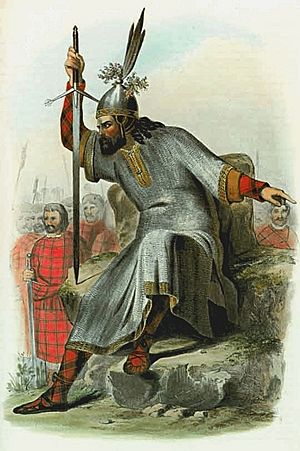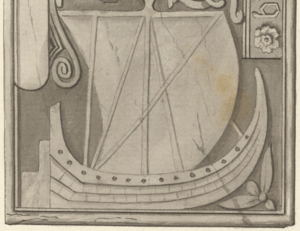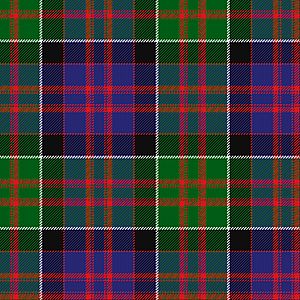Clan Macdonald of Clanranald facts for kids
Quick facts for kids Macdonald of Clanranald |
|||
|---|---|---|---|
| Clann Raghnaill | |||
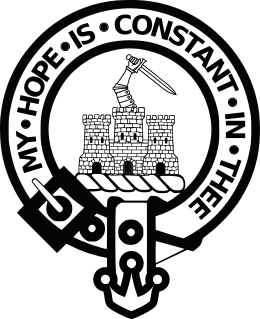
Crest: A triple-towered castle Argent masoned Sable, and issuing from the centre tower a dexter arm in armour embowed grasping a sword all Proper
|
|||
| Motto | My hope is constant in thee | ||
| War cry | Dh'aindeoin có theireadh e (Gainsay, who dares) [ə ˈɣaɲən ˈkʰoː ˈheɾʲəɣ ɛ] | ||
| Profile | |||
| District | Hebrides | ||
| Plant badge | Common heath | ||
| Chief | |||
 |
|||
| Ranald Alexander Macdonald of Clanranald | |||
| The 24th Chief and Captain of Clanranald (Mac Mhic Ailein) | |||
| Seat | Morenish House | ||
| Historic seat | Castle Tioram | ||
|
|||
|
|||
|
|||
|
|||
The Clan Macdonald of Clanranald, also known as Clan Ranald, is a historic Scottish clan from the Highlands. It is a branch of Clan Donald, which is one of the largest and most powerful Scottish clans. The Macdonalds of Clanranald trace their family roots back to Reginald, who was a great-great-great-grandson of Somerled. Somerled was a very important leader in the 12th century.
The leader of the Macdonalds of Clanranald is traditionally called The Captain of Clanranald. Today, both the chief and the clan are officially recognized by the Lord Lyon King of Arms. This person is Scotland's official judge for all things related to heraldry, like coats of arms and clan symbols.
History of the Clanranald Macdonalds
Where Did Clanranald Come From?
The Macdonalds of Clanranald are part of the huge Clan Donald. The very first ancestor of Clan Donald was Donald, son of Reginald, son of Somerled. Somerled was a powerful leader in the 1100s, sometimes called "king of the isles."
The Clanranald Macdonalds come from Donald's grandson, Angus Og. Angus Og's son, John, became the first Lord of the Isles. John first married Amie mac Ruari. She was the heir to Clann Ruaidhrí, another important family.
Later, John divorced Amie and married Margaret, the daughter of King Robert II. The children from John's first marriage, including Reginald, did not inherit the main leadership of Clan Donald. That went to the children from his second marriage. However, the Macdonalds of Clanranald and the MacDonells of Glengarry both come from Reginald, John and Amie's oldest son.
Clanranald in the 1300s
Reginald, the first chief of Clanranald, inherited most of the lands of Clann Ruaidhrí through his mother, Amie. In 1371, his father John confirmed these lands to him. King Robert II also confirmed this the next year. These lands included islands like Eigg, Rum, Uist, and Harris, plus areas on the mainland like Sunart and Lochaber.
When his father John died, Reginald's younger half-brother, Donald, became the Lord of the Isles. Reginald passed away in 1386 at Castle Tioram and was buried on Iona. His oldest son, Allan, took over as chief. However, some of Reginald's lands were taken by his brother Godfrey.
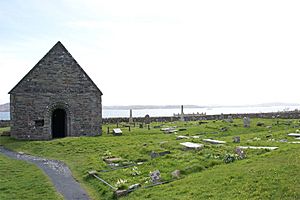
It's a bit unclear what lands the clan held during this time. The first clear record is from 1531. It shows that the lands of Moidart, Arisaig, Eigg, and South Uist were held by John Moidartach's grandfather, Allan. It seems that by Allan's time, the Clanranald family had much less land than Reginald originally had.
Clanranald in the 1400s
In 1427, King James I called a meeting in Inverness for the clan chiefs. Some chiefs were arrested and executed. Allan, Reginald's son, seems to have survived. He is recorded in official documents from 1428. This is the only direct record of Allan. He is also said to have fought in the Battle of Harlaw in 1411. Allan likely died around 1428-1430 at Castle Tioram and was buried on Iona. His oldest son, Roderick, became the next chief.
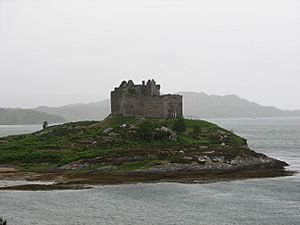
Roderick, the third chief, supported the Earl of Ross against the Scottish king. He joined an attack on Inverness in 1492, where they "pillaged and burnt the houses." In 1431, Roderick fought against the king's army at Lochaber. In 1455, he was part of a Macdonald raid on Sutherland. Even though they were defeated, Roderick managed to save most of his men.
In 1469, the Lord of the Isles gave many of Reginald's original lands to his half-brother, Hugh of Sleat. This meant that when Roderick died in 1481, his family was left with lands that were often disputed. Allan, Roderick's oldest son, became the fourth chief.
Allan, the fourth chief, was considered one of the clan's greatest leaders. He supported Angus, the son of the Lord of the Isles, in the Battle of Bloody Bay. Allan also helped Alexander of Lochalsh in the Battle of Blar Na Pairce around 1488, against the Mackenzies.
In 1491, Alexander and his allies, including the Clanranald Macdonalds, marched through the Highlands. They attacked the lands of the Earl of Huntly and took Inverness. The Clanranalds gained a lot of valuable goods from this raid. The government later ordered them to pay back the losses, but it's not known if they ever did.
When King James IV visited the Highlands, Allan was one of the few chiefs who showed his loyalty. Allan also had a big disagreement with Hector Odhar Maclean, the chief of Duart. Allan was known for being tough, even holding chiefs of other clans captive in Castle Tioram. Allan died in 1505 and was followed by his son, Ranald Bane.
Clanranald in the 1500s
Ranald Bane, like his father, was put on trial and executed in 1509 for a crime that isn't recorded. His oldest son, Dougall, became chief. But Dougall was very cruel to his own clan members. Because of this, he was killed by his clan in 1520, and his sons were not allowed to become chief. The leadership then went to his uncle, Alexander.
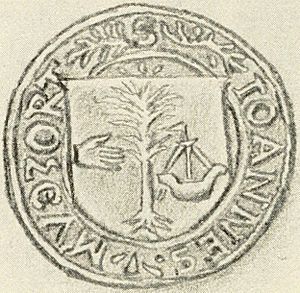
John Moidartach became the eighth chief. In 1540, King James V arrested him. During this time, Lord Lovat and the Frasers supported Ranald Gallda, another family member, as chief. John's land charters were taken away and given to Ranald Gallda.
When John Moidartach was released, Ranald Gallda had to flee. The Macdonalds of Clanranald, supported by other clans, then attacked Fraser lands. They took Castle Urquhart and plundered the area. Ranald Gallda briefly took back Moidart. But John Moidartach's supporters fought Lord Lovat and Ranald Gallda at the Battle of the Shirts in 1544. Lovat and Ranald Gallda were killed, and John Moidartach kept his position as chief.
In 1564, Mary, Queen of Scots, ordered a strong house on an island in Loch Rannoch to be destroyed. Members of Clanranald were rebuilding it, even though her father had ordered it demolished before.
John Moidartach died in 1584. His oldest son, Allan, became the ninth chief. In 1588, Allan had a fight with Alexander Macdonald of Keppoch and killed Alexander's brother. Allan was never officially forgiven for this, but he kept his lands. Allan's bad treatment of his wife caused big feuds between Clanranald and the Macleods. Allan died in 1593. His oldest surviving son, Angus, became chief but was killed shortly after. His brother, Donald, then took over.
Donald, the eleventh chief, married the daughter of Angus Macdonald of Dunnyveg. His father-in-law's clan was fighting the Macleans of Duart. Clanranald was happy about this alliance because the Macleans had previously attacked their islands. Working together, the two Macdonald chiefs attacked Coll, Mull, and Tiree, taking many goods.
In 1594, Donald Gorm Mor Macdonald of Sleat and Ruariri Mor Macleod of Harris sailed to Ireland with 500 men each to help Irish rebels. In 1595, another large group of Highlanders, including Donald and John Og MacIain, sailed to Ireland. Their fleet was attacked by English ships, and many Macdonald galleys were sunk or captured. That same year, Lachlan Mor Maclean surprised Donald's fleet and killed many Macdonalds, capturing Donald and other chiefs.
In 1601, Clanranald joined the MacDonnels of Glengarry in fighting the Mackenzies of Kintail, causing damage to the area. While they were away, Murdoch MacNeil of Barra took over lands in South Uist. Donald led his fighters back to South Uist and defeated the MacNeils, killing most of them. The remaining MacNeils fled, and Murdoch was eventually killed by Clanranald.
Donald, like other chiefs, owed money to the Scottish king. He met with the king's representatives and agreed to follow the laws. King James VI made Donald a knight in 1617. Donald died at Castle Tioram in 1618, and his son John became chief.
Clanranald in the 1600s
John, the twelfth chief, fought in the wars with Montrose. He joined Montrose and Alasdair MacColla at the Battle of Inverlochy in 1645. After the battle, he returned home to find his castle garrison attacked. He defeated the attackers and strengthened his castle. The Clanranald Macdonalds then caused damage to Sunart and Ardnamurchan. John died in 1670 and was buried on South Uist. His only son, Donald, became chief.
Donald, the thirteenth chief, lived mostly at Castle Tioram and made many repairs to it. He died in 1686 and was buried on South Uist. His oldest surviving son, Allan, became chief. Allan was educated at Inverness and by tutors at home. His main home, Castle Tioram, was taken over by King William of Orange after the Battle of Killiecrankie in 1689. The soldiers left in 1698.
Clanranald in the 1700s
Allan was badly hurt at the Battle of Sheriffmuir in 1715 and died the next day. He was buried at Innerpeffray. His brother, Ranald, became chief. In 1724, a report estimated that Clanranald could gather 800 fighting men. Ranald, the fifteenth chief, never married and died in Paris in 1725. He was followed by Donald Macdonald of Benbecula. Donald, the sixteenth chief, died in 1730. His oldest son, Ranald, became chief.
Ranald, the seventeenth chief, was born in 1692. He chose not to help Charles Edward Stuart and the Jacobites during the 1745 rebellion. However, he allowed his oldest son and heir, also named Ranald, to join the Jacobites. The chief died in 1766. His oldest son, Ranald, became the eighteenth chief.
Ranald, the eighteenth chief, was educated in France and met Charles Edward Stuart there. He was one of the first to join Charles Edward Stuart in 1745. Ranald gathered 250 clan members. After the Jacobite standard was raised at Glenfinnan, Ranald led 500 men to Dundee and declared James Francis Edward Stuart as king.
The Clanranald regiment fought at the Battle of Prestonpans and the Battle of Falkirk. At the Battle of Culloden in April 1746, the Clanranald regiment had 200 men. They were placed on the far left side of the Jacobite army, which was considered an insult. Legend says they refused to charge because of this. The Clanranald regiment was disbanded two days after their defeat at Culloden. After the rebellion, Ranald spent time in France before returning to Scotland. He died in 1776. His oldest son, John Moidartach, became chief. John Moidartach died in 1794. His oldest surviving son, Ranald George, became chief.
Clanranald from the 1800s to Today
Ranald George, the twentieth chief, was born in 1788. Between 1813 and 1838, he sold almost all the traditional Clanranald lands. These lands had been held by the family of Somerled for 800 years. He sold them to pay off his debts and fund his expensive lifestyle. By the end, the chief only owned the ruins of Castle Tioram. He died in London in 1873. His son, Reginald John James George, an admiral in the Royal Navy, became the twenty-first chief.
Reginald died in 1899. His son Allan Douglas became the twenty-second chief. Allan Douglas was a captain in the Royal Artillery. He was followed by his brother, Angus Roderick. The direct line of Clanranald chiefs ended in 1944 when Angus Roderick, the twenty-third chief, died. The leadership then passed to a branch of the clan called the Macdonalds of Boisdale.
More recently, in 2013, it was discovered that the original line might not have died out. This is currently being reviewed. The current chief is Ranald Alexander Macdonald of Clanranald. He was recognized as the twenty-fourth chief in 1956. He is a member of important Scottish clan councils.
How the Highland Clearances Affected the Clan
In the 1700s and 1800s, many ordinary clan members and other families living on Clanranald lands faced great hardship. This was due to the Highland Clearances and also religious difficulties caused by the Clanranald chief.
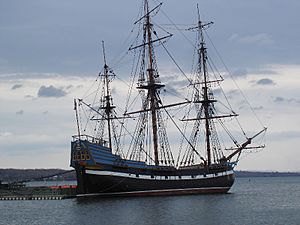
In 1769, the Clanranald chief tried to force his tenants on South Uist to become Presbyterian. He threatened to remove them from his lands if they didn't. In 1772, over 200 Roman Catholics, mostly from Clanranald's lands, moved to Prince Edward Island in Canada. They settled at Scotchfort. However, Catholics were not allowed to own land there until 1780. The first winter was very hard for them.
In 1790–1791, another 900 people from Clanranald lands moved to the area. They also suffered during their first winter. Around the same time, in 1791, another 650 people from Clanranald lands settled in Antigonish County, Nova Scotia. Hundreds more followed in the early 1800s.
On Prince Edward Island, the land owner tried to make the new settlers only tenants. But many adventurous settlers moved to better areas and claimed their own land. Scotchfort became a place for new arrivals to get settled before moving on to find their own farms.
Clan Profile
- Clan Chief: The chiefs of Clan Macdonald of Clanranald are traditionally called "The Captain of Clanranald." In Gaelic, their title is Mac Mhic Ailein. The current chief is Ranald Alexander Macdonald of Clanranald, the 24th chief.
- Chiefly Arms: The chief's coat of arms has specific symbols. It shows a red lion, a hand holding a cross, a ship with oars, and an oak tree with an eagle. Above the shield is a helmet and a castle with an arm holding a sword. The motto is "MY HOPE IS CONSTANT IN THEE." The clan's battle cry is "dh' aindeòin cò theireadh e," which means "gainsay who dare" or "in spite of all opposition."
- Clan Member's Crest Badge: Clan members can wear a badge with the chief's crest and motto. The crest is a castle with an arm holding a sword. The motto is MY HOPE IS CONSTANT IN THEE.
- Clan Badge: The plant badge for the clan is common heath. This plant is also used by other Macdonald clans.
- Pipe Music: The clan has specific bagpipe tunes, including Spaidsearachd Mhic Mhic Ailein (meaning "Clanranald's March") and Failte Clann Raounil.
- Tartan: A tartan pattern was given to the clan in a book called the Vestiarium Scoticum in 1842. Even though this book is now thought to be a fake, many of the tartans from it are still used by clans today.
Branches of the Clan
There are several smaller family groups, or branches, within Clan Macdonald of Clanranald. These include the Macdonalds of Glenaladale, Kinlochmoidart, Belfinlay, and Boisdale. There is also a family called Maceachainn/Macdonalds.
- The Macdonalds of Glenaladale come from John Og, the second son of John Moidartach, the eighth chief.
- The Macdonalds of Kinlochmoidart come from John, the fourth son of Allan, the eighth chief.
- The Macdonalds of Belfinlay come from James, the second son of Ranald, a grandson of Allan, the ninth chief.
- The Macdonalds of Boisdale come from Donald of Benbecula, the sixteenth chief. When the main Clanranald line ended in 1944, the Boisdale branch was chosen to lead the clan in 1957.
The Macdonalds of Knoydart are thought to come from Allan, the second chief. Allan gave his son, Allan, the lands of Knoydart. The last of this family to hold Knoydart lands was Ranald. Around 1610, the men of Knoydart raided other lands, and because of the problems that followed, the family lost their lands.
The 'Maceachen' family of Macdonalds comes from Hector, the second son of Roderick, the third chief. Hector was given lands in Morven. The Maceachens of Howbeg and Glenuig come from Ranald, a later Hector's son. This family first lived in Uist in the 1600s. By the 1700s, many gentlemen in this family started using the surname Macdonald. The Macdonalds of Morar come from Allan, the oldest son of Dougall, the sixth chief. In 1538, Allan and his brother Lachlan were given the lands of Morar.
Families Connected to Clanranald
Many other family names are connected to Clan Macdonald of Clanranald. These families either have a direct link to the clan or lived on Clanranald's traditional lands.
| Names | Notes |
|---|---|
| Allan, Burke | Allans from the West Highlands who allied with Clanranald. Burkes from Antrim who moved to Uist and Benbecula. |
| Lynn | Only those from South Uist and Benbecula. Their name comes from Gaelic O'Fhloinn or O'Loinn. |
| MacCellach, MacCulloch, MacKelloch, Kelly | Only those from the West Highlands and Hebrides who allied with Clanranald. Their name comes from Mac Cellaigh. |
| MacCormick | Only those who came to South Uist from Ireland in the 1700s as missionaries. |
| MacCuithein, MacKeithan, MacWhithee, MacQueen | The MacQueens of Benbecula and South Uist are connected to Clanranald. They were originally MacCuitheins from Skye. |
| MacDougall | Only one family of MacDougalls from North Uist is connected to Clanranald. They come from Dugald, son of Ranald, the first chief. |
| MacEachan, MacGachen, MacGeachie, McGeachie, MacKeachan, MacKechnie, MacKichan, MacAichan, McGechan, McGechaen | Those from the West Highlands and Islands might be connected to Clanranald. They are thought to come from Hector, second son of Roderick, the third chief. |
| MacGillies, Gillies, Gillis, Gill | Only those from Morar are connected to Clanranald. |
| MacGorrie, Currie/Curry/McCurry/Godfrey/Jeffrey | Only those from Benbecula and South Uist are connected to Clanranald. Their name comes from Mac Goraidh. |
| MacGowan, Gowan, Smith | Only those from the West Highlands and Islands are connected to Clanranald. Their name means "son of the smith." |
| MacIllimhicall, MacMichael, MacMitchell, Michael/Michaelson/Mitchell/Mitchelson/Carmichael | Only those from Clanranald lands are connected to Clanranald. Their name means "son of the servant of St. Michael." |
| MacInnes, MacGinnis | Those from the West Highlands and Hebrides are connected to Clanranald. |
| MacIntyre, MacEntire, Wright | This family is said to be from the same ancestors as Clan Donald. They are connected to Clanranald. Their name means "son of the carpenter." |
| MacIsaac, MacKessock, Isaacson/Kessock | Those from Moidart were originally connected to Clan Donald. Those from South Uist are connected to Clanranald. |
| MacLellan, MacClellan, MacGillelan, Gililan | Only those from South Morar and South Uist are connected to Clanranald. |
| MacLulich, MacCulloch | Those from the West Highlands, Hebrides, and Antrim might be connected to Clanranald. Their name comes from Mac Lulaich. |
| MacManechin, Monk | Only those from Benbecula are connected to Clanranald. Their name means "son of the monk." |
| MacMhuirich, MacBurie, MacMurrich, MacVurrich, MacWurie, Currie/Curry/MacCurry | This family is found throughout Clanranald lands. They were the traditional poets and storytellers for the Lord of the Isles and later for Clanranald. |
| MacQuilly | Those from Eigg are connected to Clanranald. Their name comes from Mac Choiligh ("son of the cock"). |
| MacRuairi, MacRory, MacRury MacCrory, Rorieson, Rory | Those from the West Highlands and Islands are connected to Clanranald. |
| MacVarish, MacWarish, MacMoris | Only those from Moidart. Their name comes from Mac Bharrais. |
| Park | Only Parks from the West Highlands and Islands or Antrim who were originally Chlann ic Phairce are connected to Clan Donald. Only those from South Uist are connected to Clanranald. |
More to Explore
- Books of Clanranald, old writings by the MacMhuirich bards.
- Lord of Clanranald, a special title.
- The Clanranald Trust for Scotland, a group that does historical reenactments and entertainment.


